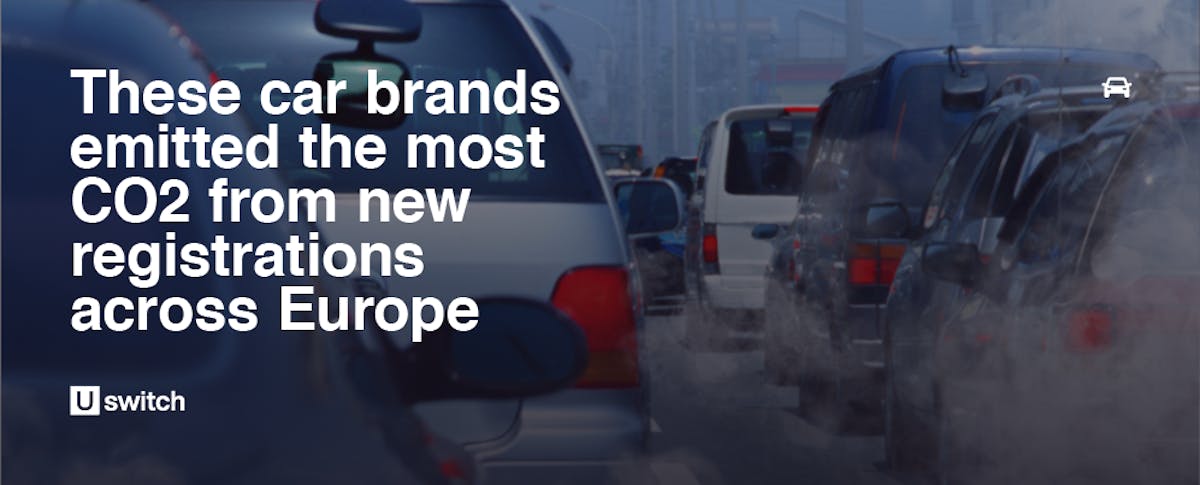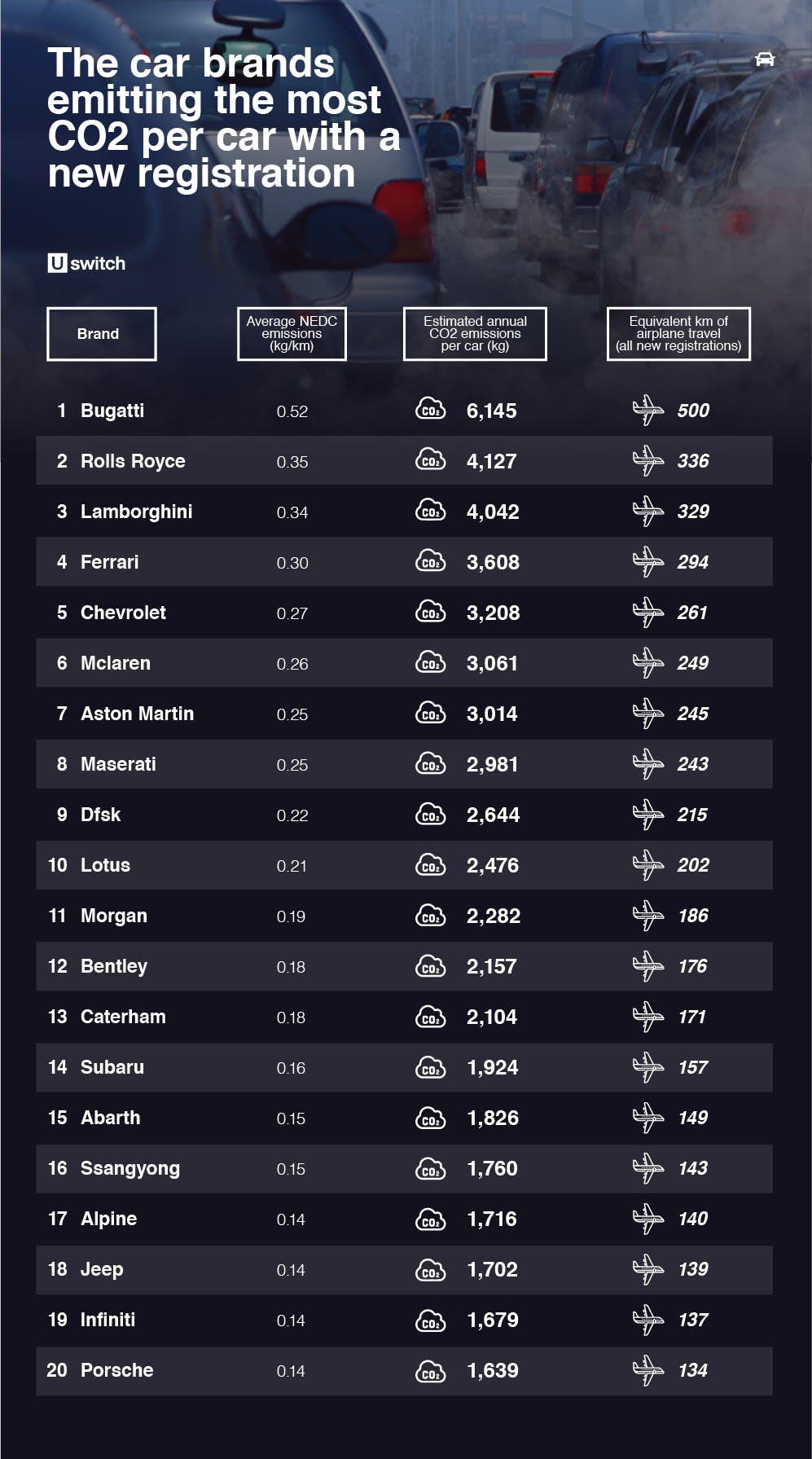The car brands emitting the most CO2 from new registrations in 2020
By 2030, all new petrol or diesel cars will be obsolete in a bid to save our planet. But just how much do our cars impact the environment? Uswitch investigated.

Thanks to technological advancements and growing lobbying against the automotive industry, the levels of CO2 production amongst vehicles has begun to decrease. However, with the planet remaining at substantial risk of further deterioration, this drop in emissions is still not low enough, with some figures suggesting that, contrary to eco-conscious goals, some newer cars produce more CO2 than older models. Keen to discover the scale of pollution created by new registrations, and which car brands are most responsible, we conducted a study of all new registrations from 2020 and their potential polluting effects, revealing which car brands emit the most CO2 from new registrations overall, and per car.
The car brands emitting the most CO2 from new registrations combined
In order to determine which car brands’ new registrations were estimated to be responsible for emitting the most CO2 last year, we used the data made available by the European Environment Agency monitoring the CO2 emissions from new passenger cars. Combining this data with the amount that Brits are estimated to drive each year and the number of new registrations for each brand, we were able to determine which car brands may be the biggest polluters overall, across all new registrations combined.

According to our study, Ford was estimated to emit the most CO2 in total across all of their new registration cars collectively last year. In fact, our analysis found the total CO2 emissions estimated to be produced from Ford’s new registrations combined was 30,160 kg per kilometre, which is equivalent to flying 1,526 miles – a trip from London to Algeria.
This is largely down to the fact that Ford also had the highest number of new registrations – 236,072 in total – since the emissions estimated to be produced per car were considerably lower than most other car brands, including Jeep, Aston Martin, Bentley and many others.
Similarly, we found that all of Volkswagen’s new registration cars combined were estimated to produce the second highest amount of CO2 emissions, despite each car being estimated to produce 1,442 kg of CO2 each year. Since Volkswagen had the second highest number of new registrations (201,786), their total CO2 emissions from new registrations combined were estimated to be 24,549 kg per kilometre, which is roughly equivalent to flying 1,242 miles, or making the journey from London to Sofia by plane.
Meanwhile, Mercedes was revealed to be the car brand estimated to produce the third highest amount of CO2 emissions from their new registrations combined. Not only did Mercedes have the third highest number of new registrations, with 171,515, but their new registrations were also found to produce one of the highest New European Driving Cycle (NEDC)-estimated annual emissions per car - 0.12 kg per kilometre. These factors combined mean that the brand was estimated to emit 24,265 kg of CO2 per kilometre. This roughly equates to flying 1,227 miles or travelling from London to Albania by plane.
The car brand whose new registrations were estimated to be responsible for the fourth highest quantity of CO2 emissions combined was BMW. With 169,586 new registrations and an average NEDC of 0.1 kg per kilometre, BMW’s new registration emissions combined tally up to an estimated CO2 production of 22,366 kg per kilometre, which equates to flying roughly 1,131 miles, or flying from London to Helsinki in terms of air miles.
Vauxhall, Audi and Land Rover followed in fifth, sixth, and seventh, respectively, as the car brands whose new registrations created the next highest amount of CO2 when combined last year. In fact, despite Land Rover having just over half of the number of new registrations than Audi last year, the car brand had one of the highest NEDC averages (0.12 kg per kilometre), meaning that it still placed as the seventh most polluting, with an estimated total CO2 emission of 13,110 kg per kilometre for the new registrations combined.
The car brands emitting the most CO2 per car with a new registration
In order to determine specifically which car brands are estimated to emit the most CO2 per new car with a new registration, we also calculated the annual CO2 emissions per car in grams for each brand to reveal which brands produce the most CO2.

Our study found Bugatti to be the brand whose new registrations produce the highest quantity of CO2 emissions per car, with each estimated to emit a staggering 6,145 kg of the pollutant on average each year – equivalent to travelling 500 kilometres by plane. This finding can be attributed to the fact that Bugatti had the highest average NEDC emissions, with 0.5 kg per kilometre. Fortunately, Bugatti had only four new registrations last year, meaning that the estimated CO2 emissions from these new registrations combined were still one of the lowest overall.
Rolls Royce followed shortly in second, with an average NEDC emission of 0.35 kg per kilometre and an estimated 4,127 kg of CO2 emitted per new registration car annually. Rolls Royce had 451 new registrations last year, meaning that the estimated emissions of all their new registrations combined were equivalent to 12.7 kilometres of air travel, which is considerably less than the 2,456 kilometres of air travel that Ford’s estimated CO2 emissions were equivalent to for all of their new registrations combined.
Supercars Lamborghini and Ferrari also ranked among the car brands emitting the most CO2 per car with a new registration last year, with the estimated quantity of CO2 emitted per car said to be equivalent to 329 kilometres and 293 kilometres of air travel respectively. Lamborghini’s new registration cars had an average NEDC emission of 0.34 kg per kilometre, which equates to an estimated production of 4,042 kg of CO2 emitted annually per car. In comparison, Ferrari had an average NEDC emission of 0.3 kg, which is equivalent to an estimated 3,608 kg of CO2 emitted each year by a single car.
If you are concerned about how much CO2 your car is emitting, it might be time to make the switch to an electric vehicle. There is a long list of pros when it comes to purchasing an electric vehicle, and now is the perfect time to invest due to the various government schemes and incentives put in place by the government. Find out more about making electric vehicles in our guide here.
Methodology:
